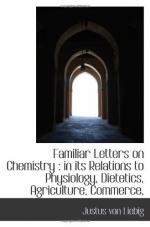LETTER VIII
My dear Sir,
Having attempted in my last letter to explain to you the simple and admirable office subserved by the oxygen of the atmosphere in its combination with carbon in the animal body, I will now proceed to present you with some remarks upon those materials which sustain its mechanisms in motion, and keep up their various functions,—namely, the Aliments.
If the increase in mass in an animal body, the development and reproduction of its organs depend upon the blood, then those substances only which are capable of being converted into blood can be properly regarded as nourishment. In order then to ascertain what parts of our food are nutritious, we must compare the composition of the blood with the composition of the various articles taken as food.
Two substances require especial consideration as the chief ingredients of the blood; one of these separates immediately from the blood when it is withdrawn from the circulation.
It is well known that in this case blood coagulates, and separates into a yellowish liquid, the serum of the blood, and a gelatinous mass, which adheres to a rod or stick in soft, elastic fibres, when coagulating blood is briskly stirred. This is the fibrine of the blood, which is identical in all its properties with muscular fibre, when the latter is purified from all foreign matters.
The second principal ingredient of the blood is contained in the serum, and gives to this liquid all the properties of the white of eggs, with which it is indeed identical. When heated, it coagulates into a white elastic mass, and the coagulating substance is called albumen.
Fibrine and albumen, the chief ingredients of blood, contain, in all, seven chemical elements, among which nitrogen, phosphorus, and sulphur are found. They contain also the earth of bones. The serum retains in solution sea salt and other salts of potash and soda, in which the acids are carbonic, phosphoric, and sulphuric acids. The globules of the blood contain fibrine and albumen, along with a red colouring matter, in which iron is a constant element. Besides these, the blood contains certain fatty bodies in small quantity, which differ from ordinary fats in several of their properties.
Chemical analysis has led to the remarkable result, that fibrine and albumen contain the same organic elements united in the same proportion,—i.e., that they are isomeric, their chemical composition—the proportion of their ultimate elements—being identical. But the difference of their external properties shows that the particles of which they are composed are arranged in a different order. (See Letter V).
This conclusion has lately been beautifully confirmed by a distinguished physiologist (Denis), who has succeeded in converting fibrine into albumen, that is, in giving it the solubility, and coagulability by heat, which characterise the white of egg.




